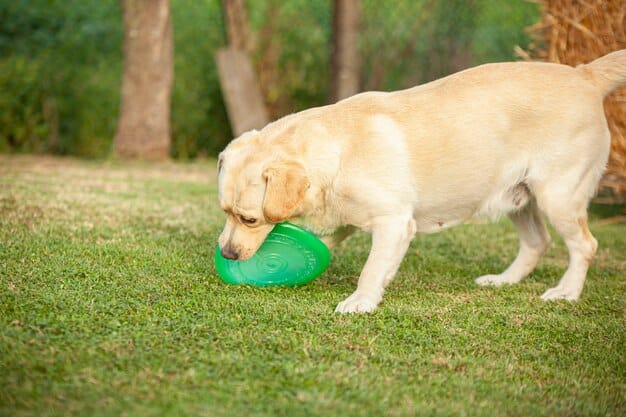Sustainable Paws: Eco-Friendly Pet Products Demand Soars in the US

Anúncios
The growing demand for sustainable and eco-friendly pet products reflects a significant shift in consumer behavior as pet owners in the US increasingly prioritize the environmental impact of their purchasing decisions, seeking options that are both safe for their pets and beneficial for the planet.
The bond between humans and their pets is undeniable, and now, that connection extends to a shared concern for the planet. The growing demand for sustainable and eco-friendly pet products isn’t just a trend; it’s a reflection of values-driven purchasing by US pet owners.
Anúncios
The Rise of Conscious Pet Ownership
Pet owners are becoming increasingly aware of the environmental footprint associated with pet products. This awareness is driving a demand for alternatives that minimize harm to the planet, aligning with broader sustainability movements.
From food to toys, bedding to grooming supplies, the pet industry is undergoing a green transformation. This shift is being fueled by informed consumers who are seeking products that are ethically sourced, sustainably produced, and environmentally friendly.
Anúncios
Understanding the Eco-Conscious Pet Owner
Eco-conscious pet owners are characterized by their commitment to reducing their environmental impact in all aspects of their lives, including how they care for their pets. They are willing to invest in products that reflect these values.
- Prioritizing products made from recycled or renewable materials.
- Seeking out brands with transparent and ethical supply chains.
- Choosing products that minimize packaging and waste.
- Supporting companies committed to environmental conservation.
This rise in conscious pet ownership is not just a fleeting trend but a fundamental shift in consumer behavior. It is reshaping the pet industry and driving innovation in sustainable pet product development.
In summary, the increasing awareness of environmental impact among pet owners is transforming the pet industry, leading to a surge in demand for sustainable and eco-friendly pet products.
The Environmental Impact of Traditional Pet Products
Traditional pet products often have a significant environmental impact due to their manufacturing processes, materials used, and disposal methods. Understanding these impacts is crucial to appreciating the need for sustainable alternatives.
From plastic toys to chemically-treated grooming products, the environmental consequences of traditional pet products are far-reaching. These products can contribute to pollution, habitat destruction, and resource depletion.

Examining the Use of Plastics in Pet Products
Many pet toys, food bowls, and accessories are made from plastic, a material derived from fossil fuels. The production of plastic contributes to greenhouse gas emissions and pollution.
Furthermore, plastic waste can persist in the environment for hundreds of years, polluting ecosystems and harming wildlife. The use of durable, non-biodegradable plastics extends the environmental impact of many pet products long after they are discarded.
- Plastic production contributes to greenhouse gas emissions
- Plastic waste persists in the environment for centuries
- Plastic pollution harms wildlife and ecosystems
- Alternatives, such as recycled plastics and biodegradable materials, exist.
The environmental impacts of using plastics in pet products are substantial, contributing to pollution and resource depletion. Embracing sustainable alternatives is vital for reducing these negative effects and helping preserve the environment.
Sustainable Materials Gaining Popularity
The growing demand for eco-friendly pet products is driving innovation in sustainable materials. From hemp to bamboo, manufacturers are exploring alternatives that minimize environmental impact.
These materials offer a range of benefits including renewability, biodegradability, and reduced carbon footprint. As consumers become more conscious of their purchasing decisions, sustainable materials are gaining prominence in the pet product market.
Spotlight on Hemp, Bamboo, and Recycled Materials
Hemp is a versatile, fast-growing plant that requires minimal pesticides and fertilizers. Its fibers are strong and durable, making it an excellent material for pet toys, bedding, and leashes.
Bamboo is another rapidly renewable resource that is naturally antibacterial and odor-resistant. It’s used in pet bowls, grooming tools, and even cat litter providing a sustainable solution for pet owners.
Recycled materials, such as recycled plastic and rubber, offer a way to divert waste from landfills and reduce the demand for virgin resources. These materials are used in a variety of pet products, from toys to beds.
In conclusion, the increasing popularity of sustainable materials like hemp, bamboo, and recycled plastics is transforming the pet product industry, offering environmentally conscious options for pet owners.
Eco-Friendly Pet Food and Treats
Sustainable pet food and treats are gaining traction as pet owners become more attuned to the environmental impact of their pets’ diets. These options focus on reducing the carbon footprint of pet food production.
From responsibly sourced ingredients to eco-friendly packaging, manufacturers are exploring ways to minimize the environmental impact of pet food. This includes using alternative protein sources and reducing waste in the supply chain.

- Seeking out brands that use alternative protein sources, like insect protein
- Choosing pet food with organic and locally sourced ingredients
- Selecting food packaged in recyclable or biodegradable materials
- Supporting companies committed to sustainable farming practices
Eco-friendly pet food and treats represent a growing segment of the market, driven by pet owners who prioritize sustainability and ethical sourcing. These products contribute to a healthier planet and a more environmentally responsible pet industry.
Ultimately, eco-friendly pet food and treats are becoming increasingly popular as pet owners seek to minimize the environmental impact of their pets’ diets, leading to a more ecological and responsible pet industry.
The Role of Packaging in Sustainability
Packaging plays a crucial role in the sustainability of pet products. Traditional packaging materials, such as plastic, can contribute to waste and pollution. Eco-friendly packaging alternatives are essential for reducing environmental impact.
From recyclable cardboard to biodegradable pouches, innovative packaging solutions are emerging to minimize waste and reduce the carbon footprint of pet products. These options reflect a commitment to sustainability and environmental responsibility.
Exploring Recyclable and Biodegradable Options
Recyclable packaging, such as cardboard and certain types of plastic, can be diverted from landfills and repurposed into new products. This reduces waste and conserves resources.
Biodegradable packaging breaks down naturally over time, minimizing its environmental impact. Materials like compostable pouches and plant-based packaging are gaining popularity as sustainable solutions.
- Selecting products with minimal packaging to reduce waste
- Opting for packaging made from recycled materials whenever possible
- Supporting brands that use biodegradable or compostable packaging
- Recycling or properly disposing of packaging materials
Eco-friendly packaging is an integral part of creating sustainable pet products. By minimizing waste and using recyclable or biodegradable materials, packaging can significantly reduce the environmental impact of pet products.
In conclusion, eco-friendly packaging is essential for minimizing the environmental impact of pet products. This includes utilizing recyclable and biodegradable options, reducing waste, and supporting brands committed to sustainability.
Navigating Greenwashing and Authenticity
As the demand for sustainable pet products grows, so does the potential for greenwashing – the practice of making misleading or unsubstantiated claims about a product’s environmental benefits.
Consumers must remain vigilant and informed to distinguish genuine eco-friendly products from those making false claims. This involves carefully evaluating product labels, certifications, and company practices.
Tips for Spotting Genuine Eco-Friendly Products
Look for reputable certifications, such as the USDA Organic, EcoCert, or B Corp labels, which verify that a product meets certain environmental and social standards.
Evaluate the transparency of a brand’s supply chain and manufacturing processes. Companies committed to sustainability are often willing to provide detailed information about their practices.
- Look for third-party certifications and labels
- Check the transparency of the brand’s supply chain
- Read product labels carefully for specific environmental claims
- Research the company’s environmental initiatives
Understanding how to identify authentic eco-friendly products is crucial for making responsible purchasing decisions. By remaining vigilant and informed, consumers can support sustainable practices and avoid greenwashing tactics.
Therefore, navigating greenwashing and ensuring authenticity by looking for certifications, examining transparency, and researching companies are crucial steps for consumers seeking genuine eco-friendly pet products.
| Key Aspect | Brief Description |
|---|---|
| 🌱 Eco-Friendly Materials | Use of hemp, bamboo, and recycled materials in pet products. |
| ♻️ Sustainable Packaging | Focus on recyclable and biodegradable packaging options. |
| 🐾 Eco-Conscious Owners | Growing awareness among pet owners about environmental impact. |
| 🛡️ Avoiding Greenwashing | Tips for identifying authentic eco-friendly pet products. |
Frequently Asked Questions
▼
Sustainable materials include hemp, bamboo, recycled plastic, and organic cotton. These materials are renewable, biodegradable, or made from recycled content, reducing the environmental impact of pet products.
▼
Look for pet food and treats that use responsibly sourced ingredients, such as organic or locally sourced options. Brands committed to sustainability often use eco-friendly packaging and reduce waste in their supply chain.
▼
Greenwashing is when a company makes misleading claims about the environmental benefits of its products. Avoid it by looking for third-party certifications, checking the brand’s transparency, and reading product labels carefully.
▼
Sustainable packaging reduces waste and minimizes the environmental impact of pet products. Using recyclable, biodegradable, or compostable materials helps to conserve resources and reduce pollution from landfills.
▼
While some eco-friendly pet products may have a higher upfront cost, they often provide long-term value by being more durable and safer for your pet and the environment. Investing in sustainability pays off in the long run.
Conclusion
The increasing demand for sustainable and eco-friendly pet products demonstrates a broader shift towards conscious consumerism. By prioritizing environmental responsibility, pet owners are driving positive change in the pet industry and contributing to a healthier planet for both themselves and their beloved companions.






